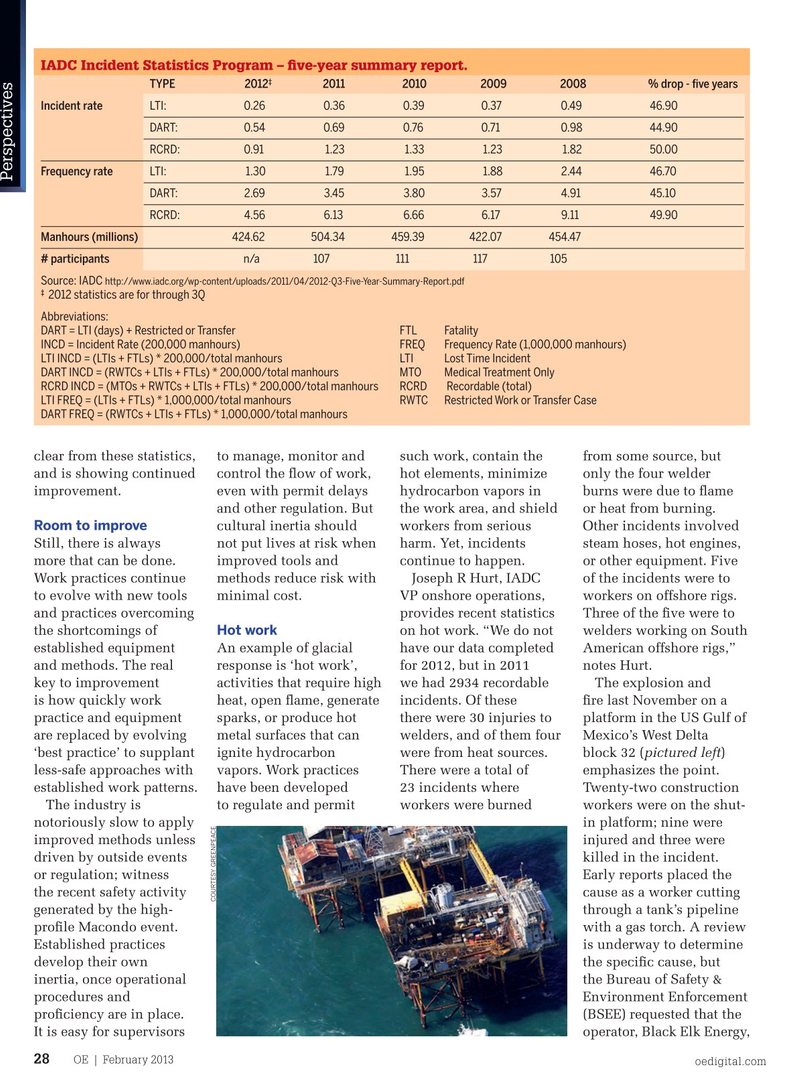
Page 26: of Offshore Engineer Magazine (Feb/Mar 2013)
Read this page in Pdf, Flash or Html5 edition of Feb/Mar 2013 Offshore Engineer Magazine
IADC Incident Statistics Program – fve-year summary report. ‡ TYPE 2012 2011 2010 2009 2008 % drop - fve years
Incident rate LTI: 0.26 0.36 0.39 0.37 0.49 46.90 DART: 0.54 0.69 0.76 0.71 0.98 44.90 RCRD: 0.91 1.23 1.33 1.23 1.82 50.00
Frequency rate LTI: 1.30 1.79 1.95 1.88 2.44 46.70
Perspectives DART: 2.69 3.45 3.80 3.57 4.91 45.10 RCRD: 4.56 6.13 6.66 6.17 9.11 49.90
Manhours (millions) 424.62 504.34 459.39 422.07 454.47 # participants n/a 107 111 117 105
Source: IADC http://www.iadc.org/wp-content/uploads/2011/04/2012-Q3-Five-Year-Summary-Report.pdf ‡ 2012 statistics are for through 3Q
Abbreviations:
DART = LTI (days) + Restricted or Transfer FTL Fatality
INCD = Incident Rate (200,000 manhours) FREQ Frequency Rate (1,000,000 manhours)
LTI INCD = (LTIs + FTLs) * 200,000/total manhours LTI Lost Time Incident
DART INCD = (RWTCs + LTIs + FTLs) * 200,000/total manhours MTO Medical Treatment Only
RCRD INCD = (MTOs + RWTCs + LTIs + FTLs) * 200,000/total manhours RCRD Recordable (total)
LTI FREQ = (LTIs + FTLs) * 1,000,000/total manhours RWTC Restricted Work or Transfer Case
DART FREQ = (RWTCs + LTIs + FTLs) * 1,000,000/total manhours clear from these statistics, to manage, monitor and such work, contain the from some source, but and is showing continued control the fow of work, hot elements, minimize only the four welder improvement. even with permit delays hydrocarbon vapors in burns were due to fame and other regulation. But the work area, and shield or heat from burning.
Room to improve cultural inertia should workers from serious Other incidents involved
Still, there is always not put lives at risk when harm. Yet, incidents steam hoses, hot engines, more that can be done. improved tools and continue to happen. or other equipment. Five
Work practices continue methods reduce risk with Joseph R Hurt, IADC of the incidents were to to evolve with new tools minimal cost. VP onshore operations, workers on offshore rigs. and practices overcoming provides recent statistics Three of the fve were to the shortcomings of Hot work on hot work. “We do not welders working on South established equipment An example of glacial have our data completed American offshore rigs,” and methods. The real response is ‘hot work’, for 2012, but in 2011 notes Hurt. key to improvement activities that require high we had 2934 recordable The explosion and is how quickly work heat, open fame, generate incidents. Of these fre last November on a practice and equipment sparks, or produce hot there were 30 injuries to platform in the US Gulf of are replaced by evolving metal surfaces that can welders, and of them four Mexico’s West Delta ‘best practice’ to supplant ignite hydrocarbon were from heat sources. block 32 (pictured left) less-safe approaches with vapors. Work practices There were a total of emphasizes the point. established work patterns. have been developed 23 incidents where Twenty-two construction The industry is to regulate and permit workers were burned workers were on the shut- notoriously slow to apply in platform; nine were improved methods unless injured and three were driven by outside events killed in the incident. or regulation; witness Early reports placed the the recent safety activity cause as a worker cutting courtesygreenpeace generated by the high- through a tank’s pipeline profle Macondo event. with a gas torch. A review
Established practices is underway to determine develop their own the specifc cause, but inertia, once operational the Bureau of Safety & procedures and Environment Enforcement profciency are in place. (BSEE) requested that the
It is easy for supervisors operator, Black Elk Energy,
OE | February 2013 28 oedigital.com oe_analysisFEB.indd 28 31/01/2013 10:30

 25
25

 27
27